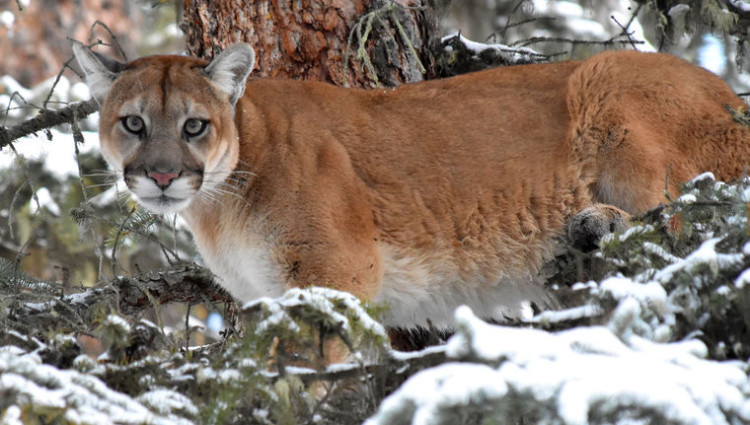
Jackson Hole News and Guide-By Mike Koshmrl
If not for a wolf pack attacking a horse in a Buffalo Valley pasture, the mountain lion now known as F72 could have come and gone without cougar researchers ever having known.
But late last week three wolves got into Jack Hatch’s horses, maiming one badly, and the houndsman grabbed his dog and followed the lobos’ tracks to “see where they came from.”
Along the way he caught a lion track — a rarity in the region these days — and followed it onto a high ridge.
Where Hatch left off, a team of biologists with Panthera’s Teton Cougar Project regained the trail.
Two nights had gone by since the mountain lion had passed through the pasture, and Saturday at dawn Connor O’Malley and Jeremy Williams were creeping along in a pickup truck, on the lookout for cougar tracks. Anything big and round with short strides warranted a stop and closer look.
“It’s so easy to miss the cat tracks,” O’Malley said. “You see elk, elk, elk, wolf, wolf, and the cat tracks somehow slip through.”
Miles away Cougar Project leader Mark Elbroch and hired houndsman Boone Smith were hot on the trail of a female lion.
At about noon, five hours into the chase, Elbroch radioed that he had spotted two cats. It was uplifting news for a team that knew the odds of a capture had just gone way up.
A new trackable mountain lion in Buffalo Valley would be a huge coup for the Kelly-based nonprofit research group, which hasn’t collared a cat that has stuck around the drainage for years.
By 2:45 p.m. the adult cougar had been treed for the third time. Perhaps 20 feet off the ground, she looked anxious and was eyeing an escape route.
The big cat didn’t bother descending from the perch but rather impressively launched herself onto a snow-covered hillside and bounded out of view.
But the cat was tired, and 10 minutes later she was up a tree again, this time maybe 30 feet high and with few large support branches beneath her — less than ideal capture conditions.
Noting that the terrain and trees nearby were similar, Elbroch made the call to attempt to tranquilize the cat.
Ketamine, a hallucinogenic anesthetic, is the drug that’s initially used to immobilize a lion.
Once it sets in, Smith ordinarily climbs the tree with gear and lowers still-awake but delusional cats down by hand.
But it was cold in the Buffalo Valley on Saturday afternoon, and though the first ketamine dart connected it had frozen and failed to fully dispense.
Minutes later a second dart whacked the cat’s haunches, causing her to drop from her perch and hightail it for a fourth time.
The second dart fully dispensed the drug.
A young mother
Hearing word, the squad of scientists and lion trackers packed up and followed her tracks, hoping to find the female cougar as quickly as possible. With the cat incapacitated, the dogs were kept tied up.
The biologists inspected its body to make sure the 30-foot drop caused no damage. Almost immediately they found porcupine quills imbedded in the cat’s chest and paws — evidence of last night’s dinner.
Over the next 45 minutes the sleeping lion was subjected to an array of tests. Blood samples were taken, limbs were measured, paws were inspected and she was weighed in at 79.2 pounds. All the while her temperature was monitored to make sure the chase hadn’t caused her to dangerously overheat.
By checking gum recession around the feline’s canine teeth, the team aged her at 2 1/2 years, a true youngster for a mother cougar. She got a name, too: F72.
The capture of F72 brings Teton Cougar Project up to seven research cats. Just as importantly, she expands the geographic reach of the team’s monitoring to the Buffalo Valley, a former lion stronghold.
“You don’t hardly find a cat around here anymore,” Hatch said. “This used to be full of cats right here, but wolves wiped them out.
“Usually they steal their kills, and they end up starving to death,” he said. “If that female gets knocked off of two, three kills in a row, she’s going to starve to death.”
Wolves and hunting
A decade and a half of Teton Cougar Project data confirms that wolves have taken a toll on lions, especially young ones, Elbroch said. But hunting, he said, has had a larger effect on overall mortality.
“The synopsis version of what’s happening on the landscape is that cats are way down,” Elbroch said. “Adults are primarily killed by people, small kittens are primarily killed by wolves, and kittens old enough to run up trees are primarily dying from starvation.”
In the few days since F72 was captured she has returned to the porcupine kill site, the collar data told the team. Otherwise, she has been on the move in the wooded hills of the vast Leidy Highlands.
In coming days and months the collar will also lead the Cougar Project to kill sites and help biologists understand how F72 is a making a go of it. One day, perhaps, the device will also tell the researchers how she dies.
Although Elbroch admittedly pulls for his cats, he has a bleak prognosis for F72.
“She’s in the toughest spot possible to survive,” Elbroch said.
Based on her age — the equivalent of a human teenager — it’s the lion’s first winter on her own, he said. She lives in a valley with deep snow, little game and lots of competing wolves and grizzly bears.
“If that’s not hard enough, she now has to care for and feed another mountain lion, who will be increasingly growing and demanding,” Elbroch said.
“Life is about as hard as it gets for F72.”
Read the full article here.
